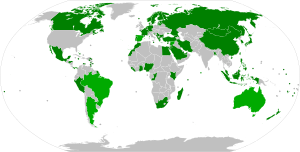
Back اتفاقية إدارة مياه الصابورة Arabic Ballastwasser-Übereinkommen German バラスト水管理条約 Japanese ბალასტის წყლის მენეჯმენტის კონვენცია Georgian Internationaal Verdrag voor de controle en het beheer van ballastwater en sedimenten van schepen Dutch Balast suyu yönetimi Turkish Конвенція про баластні води Ukrainian 国际船舶压载水和沉积物控制与管理公约 Chinese
| International Convention for the Control and Management of Ships' Ballast Water and Sediments | ||
|---|---|---|

| ||
| Signed | 13 February 2004 | |
| Location | London, United Kingdom | |
| Effective | 8 September 2017 | |
| Condition | Ratifications by at least 30 parties, whose combined merchant fleets' gross tonnage includes at least 35% of the world's | |
| Parties | 86 (15 July 2021)[1] | |
| Depositary | UN Secretary-General | |
| Languages | Arabic, Chinese, English, French, Russian, and Spanish | |
| Admiralty law |
|---|
| History |
| Features |
| Contract of carriage/Charterparty |
| Parties |
| Judiciaries |
| International conventions |
| International organizations |
The International Convention for the Control and Management of Ships' Ballast Water and Sediments (Ballast Water Management Convention or BWM Convention) is a 2004 international maritime treaty which requires signatory flag states to ensure that ships flagged by them comply with standards and procedures for the management and control of ships' ballast water and sediments.[2] The Convention aims to prevent the spread of harmful aquatic organisms from one region to another and halt damage to the marine environment from ballast water discharge, by minimising the uptake and subsequent discharge of sediments and organisms.[2] From 2024, all ships are required to have approved Ballast Water Management Treatment System, according to the D2 standard (see below). Existing ships are required to install an approved system, which may cost up to US$5 million per ship to install.[3] To assist with implementation, the IMO has released 14 Guidance documents in regards to the Convention including the G2 Guidelines for Ballast Water Sampling, G4 Guidelines for Ballast Water management and G6 Guidelines for Ballast Water Exchange.[4] As of 15 July 2021, 86 countries were contracting States to the BWM Convention (representing 91.12% of the gross tonnage of the global merchant fleet).[1]
- ^ a b "Status of Conventions". IMO. Retrieved 29 July 2021.
- ^ a b "BWM Convention". International Maritime Organization. Archived from the original on 2 July 2017. Retrieved 7 July 2017.
- ^ "BWM Convention: counting the cost". Ballast Water Treatment Technology. Archived from the original on 16 July 2017. Retrieved 7 July 2017.
- ^ Anwar & Churcher, p.175